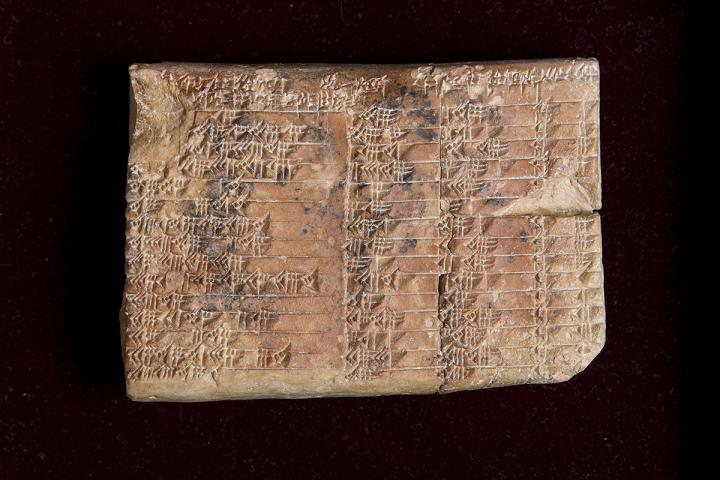
The 3,700-year-old Babylonian tablet Plimpton 322 at the Rare Book and Manuscript Library at Columbia University in New York. (Photo: UNSW/Andrew Kelly)
The code has been cracked on a 3,700-year-old clay tablet dug up in southern Iraq almost a century ago. It was Edgar J. Banks, the inspiration behind Indiana Jones, who discovered the ancient Babylonian tablet later named Plimpton 322. He eventually sold it to publisher and collector George Plimpton for $10, and it was later bequeathed by Plimpton to Columbia University in the 1930s. It’s only now that its full meaning, and importance to mathematics, is coming to light.
Thanks to the work of Dr. Mansfield and Associate Professor Norman Wildberger, both from the University of New South Wales, we have discovered that it was actually the ancient Babylonians who discovered trigonometry, not the Greeks as is commonly thought. The researchers argue that the 4 columns and 15 rows of cuneiform numbers are actually part of a highly accurate trigonometric table, not a teacher’s aid to checking student solutions to math problems—the previously accepted explanation.
“Our research reveals that Plimpton 322 describes the shapes of right-angle triangles using a novel kind of trigonometry based on ratios, not angles and circles. It is a fascinating mathematical work that demonstrates undoubted genius,” the researchers reveal in a UNSW statement.
Mathematical mystery of ancient clay tablet solved by Daniel Mansfield & Norman Wildberger @UNSWScience https://t.co/7nWafN5z0i #science pic.twitter.com/XIDuJAli9A
— UNSW News (@UNSWnews) August 25, 2017
Trigonometry, which involves the study of relationships between the lengths and angles of triangles, was thought to have been invented in ancient Greece. Greek astronomer Hipparchus, who lives around 120 BC, is regarded as the father of the field. Yet, the Plimpton 322 predates his work by more than 1,000 years.
The discovery is an important one, as most Babylonian tablets have never been closely studied. “It opens up new possibilities not just for modern mathematics research, but also for mathematics education,” shares Dr. Wildberger. “With Plimpton 322 we see a simpler, more accurate trigonometry that has clear advantages over our own.” By delving into the history of mathematics, we open up avenues to understand how ancient societies functioned. The tablet, for instance, could have been used for surveying fields or in architectural constructions of palaces or step pyramids.
h/t: [IFL Science]
Related Articles:
Coloring Book Celebrates Mathematical Beauty of Nature with Hand-Drawn Golden Ratio Illustrations
Geometric Sculptures Formed with Mathematical Equations
Documenting the Mathematical Scribbles of Geniuses
View Leonardo Da Vinci’s Notebooks Online and Go Inside the Mind of a Genius
